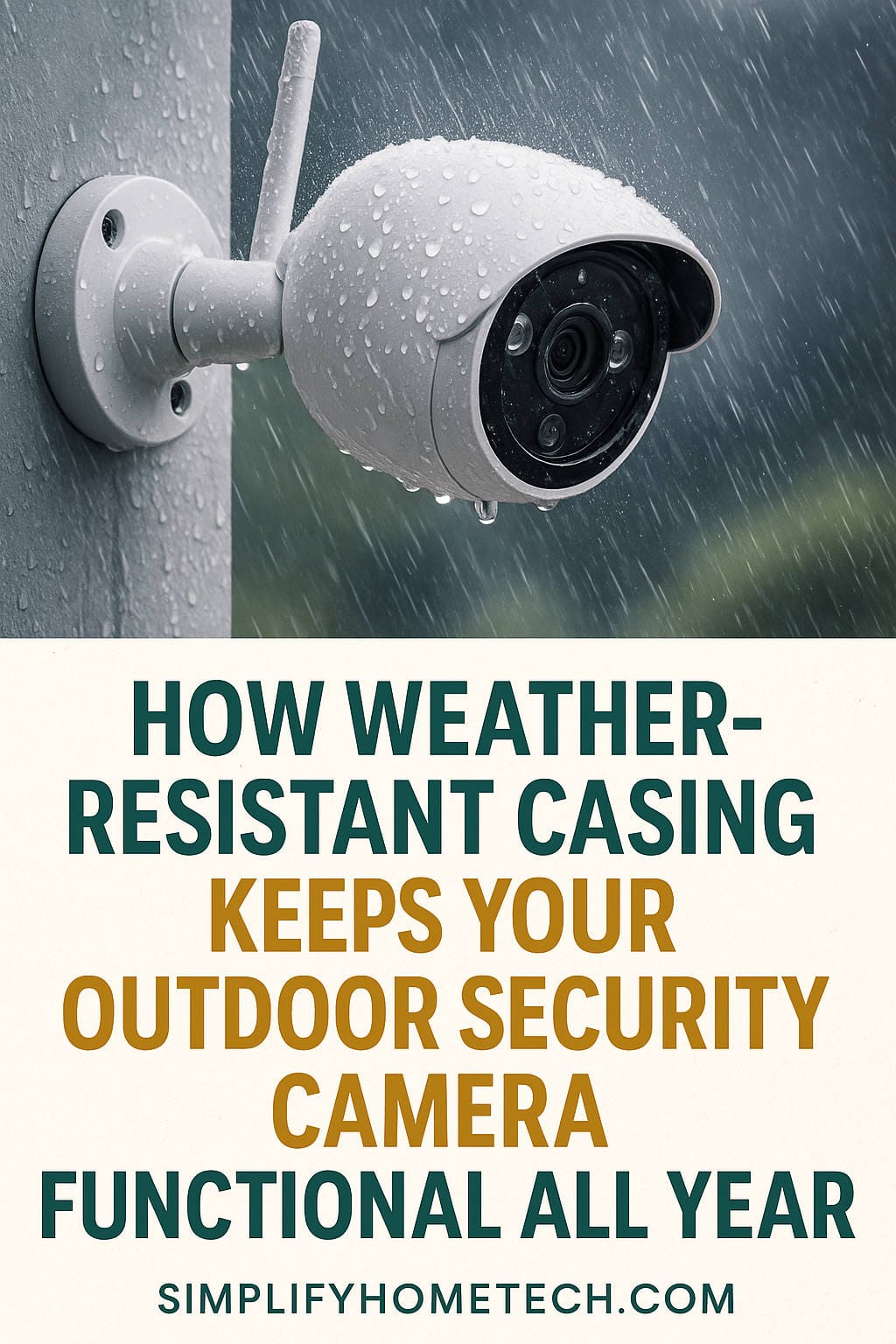In today’s ever-changing world, outdoor security cameras have evolved into a crucial component for protecting homes, businesses, and public spaces. They serve as a vigilant eye, discouraging crime, providing critical evidence, and granting peace of mind to property owners. However, these cameras are only as effective as their ability to function in the face of harsh weather. Rain, snow, extreme heat, freezing cold, dust storms, and UV radiation all pose serious threats to outdoor cameras. The key to enduring these challenges lies in one often overlooked component: the weather-resistant casing.
In this comprehensive guide, we’ll dive deep into how weather-resistant casing protects your outdoor security cameras, explore the essential features to look for, dispel common myths, and offer expert tips on installation and maintenance. By the end, you’ll understand exactly why weather-resistant casing is not just a luxury, but a necessity.
The Vital Role of Outdoor Security Cameras
Before we dive into the technicalities of weather-resistant casings, it’s important to understand the growing importance of outdoor security cameras. In both residential and commercial settings, these cameras offer several significant benefits:
- Crime deterrence: The visible presence of cameras discourages potential criminals.
- Real-time monitoring: Property owners can monitor their premises from anywhere using mobile apps and live feeds.
- Evidence collection: Recorded footage is often critical in solving crimes and settling disputes.
- Insurance benefits: Some insurers offer reduced premiums for properties with robust security systems.
But none of these benefits matter if the camera cannot withstand the environment it’s placed in.
Why Weather-Resistant Casing Is a Game Changer
Outdoor cameras face constant exposure to the elements. Without a high-quality weather-resistant casing, even the most advanced cameras are vulnerable to premature failure. Here’s what a weather-resistant casing defends against:
- Water Ingress: Moisture can corrode internal components and short-circuit electronics.
- Temperature Fluctuations: Materials can expand and contract, leading to cracks and hardware failure.
- UV Radiation: Prolonged sun exposure degrades plastics and other materials.
- Dust and Debris: Fine particles can obstruct lenses and penetrate internal compartments.
- Physical Impact: Accidents or deliberate tampering can damage exposed components.
A durable, weather-resistant casing serves as an armored shell, ensuring your camera continues to function optimally regardless of weather conditions.
Key Features of High-Quality Weather-Resistant Casings
Not all weather-resistant casings offer the same level of protection. Here are the key features you should expect in a top-tier casing:
1. Waterproofing (IP Ratings)
The most crucial element of weather resistance is protection against moisture. Outdoor cameras should have a minimum IP65 rating, but for optimal protection, IP66 or IP67 is preferable.
- IP65: Protects against water jets from any direction.
- IP66: Withstands powerful water jets and heavy rain.
- IP67: Fully protected against dust and temporary immersion in water up to 1 meter.
2. Dust Protection
Dust can accumulate on lenses, degrade image quality, and damage internal electronics. A high IP rating also ensures excellent dust protection.
3. Temperature Resilience
Extreme temperatures are common in many regions. A quality casing should withstand temperatures ranging from -20°C (-4°F) to 50°C (122°F) or more without becoming brittle or warped.
4. UV Resistance
Continuous exposure to sunlight can cause discoloration, weakening of materials, and eventual cracking. UV-resistant coatings ensure the casing maintains its integrity over time.
5. Impact and Vandal Resistance (IK Ratings)
Physical resilience is critical in areas prone to vandalism or accidental impacts. IK ratings indicate a camera’s ability to withstand mechanical shock.
- IK10 rating: Offers the highest level of impact protection, suitable for public or high-risk areas.
6. Corrosion Resistance
For coastal or industrial locations, corrosion-resistant materials like stainless steel or specially treated alloys prevent rust and degradation from salt air or chemical exposure.
The Real-World Impact of Weather-Resistant Casings
Let’s consider some specific scenarios where a robust weather-resistant casing can mean the difference between uninterrupted surveillance and costly camera failure:
Heavy Rainstorms
In tropical and temperate regions, heavy rainfall can flood areas rapidly. Without proper sealing, water ingress can damage internal electronics, short-circuit connections, and render cameras useless.
Snow and Freezing Temperatures
In cold climates, snow accumulation, freezing rain, and sub-zero temperatures are common. Quality casings prevent moisture penetration, resist cracking from thermal contraction, and some even incorporate heating elements to prevent lens fogging and ice formation.
Intense Sun and Desert Heat
In arid and desert regions, temperatures often soar above 40°C (104°F). UV-resistant materials and heat-dissipating designs ensure that cameras remain functional despite extreme heat and constant sunlight exposure.
Coastal Salt Air Exposure
In coastal areas, salt-laden air corrodes standard metal components rapidly. Corrosion-resistant casings prevent rust and material breakdown, ensuring long-term durability.
Dust Storms
In desert or dry plains, frequent dust storms introduce fine particles that can obstruct lenses and penetrate poorly sealed cameras. High IP-rated enclosures keep dust at bay.
Advanced Technologies Enhancing Weather-Resistant Casings
Thanks to advancements in engineering and materials science, modern weather-resistant casings do more than provide basic protection:
Self-Regulating Heating Systems
Cameras with built-in heating elements automatically activate when temperatures drop below freezing, preventing condensation and ice buildup on lenses.
Waterproof Ventilation Membranes
Advanced vent designs allow heat dissipation while blocking moisture and dust, maintaining optimal internal temperatures without compromising weather resistance.
Anti-Corrosion Coatings
In highly corrosive environments, specialized coatings form protective barriers against salt air, industrial pollutants, and chemical exposure.
Nano-Coatings on Lenses
Hydrophobic nano-coatings repel water, dirt, and oil from camera lenses, ensuring consistently clear images even during heavy rain or snow.
Impact-Resistant Polycarbonates
Some high-end models use aerospace-grade polycarbonate materials that offer excellent impact resistance while remaining lightweight and UV-stable.
What to Consider When Purchasing Weather-Resistant Outdoor Cameras
If you’re shopping for outdoor security cameras, consider the following factors related to weather resistance:
- IP Rating: Always check for a rating of at least IP65.
- IK Rating: For impact-prone areas, opt for IK08 or IK10 ratings.
- Operating Temperature Range: Ensure the camera can handle local climate extremes.
- Material Composition: Polycarbonate, stainless steel, or treated aluminum offer superior longevity.
- UV Protection: Verify the presence of UV-stabilized plastics and coatings.
- Corrosion Resistance: Critical for coastal, industrial, or marine environments.
Installation Best Practices to Maximize Weather Protection
Even with top-tier weather-resistant cameras, correct installation practices are vital:
Strategic Positioning
Whenever possible, install cameras under eaves, overhangs, or canopies to provide additional protection from direct rain and sunlight.
Secure Mounting
Use heavy-duty, weatherproof mounting brackets and secure fasteners to withstand wind, vibrations, and potential impacts.
Sealed Cable Entries
Ensure all cable entry points are sealed with weatherproof gaskets or conduits to prevent water ingress.
Use of Weatherproof Cables
Select outdoor-rated cables with UV-resistant and waterproof insulation to match the durability of the camera casing.
Routine Inspections
Periodically check cameras for cracks, loose fittings, or wear. Proactive maintenance can prevent minor issues from becoming major failures.
Common Myths About Weather-Resistant Security Cameras
There are several misconceptions surrounding weather-resistant cameras that need to be clarified:
Myth 1: Weather-Resistant Means Indestructible
While weather-resistant cameras offer superior protection, they are not invulnerable to extreme natural disasters like hurricanes, floods, or lightning strikes. Weather-resistant means highly durable, not indestructible.
Myth 2: All Outdoor Cameras Are Weather-Resistant by Default
Many cameras marketed for outdoor use may only provide minimal protection. Always verify specifications, certifications, and IP ratings.
Myth 3: Once Installed, Maintenance Isn’t Needed
Although maintenance needs are reduced, regular inspections and cleaning are still essential for ensuring peak performance and longevity.
Long-Term Value: Why Investing in Weather-Resistant Cameras Pays Off
While weather-resistant cameras often come with a higher upfront cost, the long-term benefits far outweigh initial expenses:
- Reduced Replacement Costs: Durable cameras last longer, reducing the frequency of replacements.
- Consistent Performance: Maintain reliable footage even during adverse conditions.
- Lower Maintenance Costs: Fewer repairs and less downtime translate into savings.
- Enhanced Property Value: Professional-grade surveillance systems add value to homes and businesses.
- Increased Security: Reliable operation ensures continuous protection when it’s most needed.
In the bigger picture, spending a bit more upfront saves you significant money, time, and frustration over the years.
Recommended Brands Known for Superior Weather-Resistant Cameras
To help you get started, here are some reputable brands that offer excellent outdoor security cameras with exceptional weather-resistant designs:
Arlo Ultra 2
- Features: 4K HDR video, IP67 weather resistance, integrated spotlight, and built-in heaters for cold climates.
Nest Cam (Outdoor or Battery)
- Features: Sleek design, reliable weatherproof casing, UV-resistant housing, and simple installation.
Ring Floodlight Cam Pro
- Features: Durable design with IP65 rating, integrated floodlights, siren, and advanced motion detection.
Reolink Argus 3 Pro
- Features: Affordable option with IP65 waterproofing, wire-free design, and flexible placement.
Axis Communications P56 Series (Enterprise-Grade)
- Features: IK10-rated impact resistance, corrosion-proof materials, advanced weather protection for industrial or commercial use.
Emerging Trends: The Future of Weather-Resistant Security Cameras
The industry continues to evolve rapidly, and several emerging trends promise even more effective weather protection in the near future:
Smart Self-Monitoring Systems
Future cameras may include AI-powered self-diagnostics to detect potential seal failures, moisture ingress, or temperature anomalies before failures occur.
Green Materials
More manufacturers are adopting eco-friendly, recyclable, and sustainable materials for weatherproof casings.
Integrated Solar Power
Built-in solar panels not only power cameras but can also regulate temperature to prevent overheating or freezing.
Enhanced AI Analytics
Advanced software can compensate for fog, rain, and snow in real-time to maintain clear image quality even during harsh conditions.
Conclusion: Weather-Resistant Casings Are the Silent Guardian
Outdoor security cameras are an investment in safety, peace of mind, and property protection. But without proper weather-resistant casings, that investment can be quickly compromised by the very elements you’re trying to protect against.
Weather-resistant casings serve as the silent guardian of your security system. They allow your cameras to function reliably through torrential rain, sweltering heat, heavy snow, dust storms, and even potential vandalism. Investing in well-designed, properly installed weather-resistant cameras ensures that your security system remains vigilant 24/7, no matter what nature throws its way.
When you combine cutting-edge camera technology with robust weatherproof designs and best installation practices, you create a security solution that stands the test of time—and weather.
Protect your property, protect your investment, and sleep better knowing your surveillance system is ready for anything.

